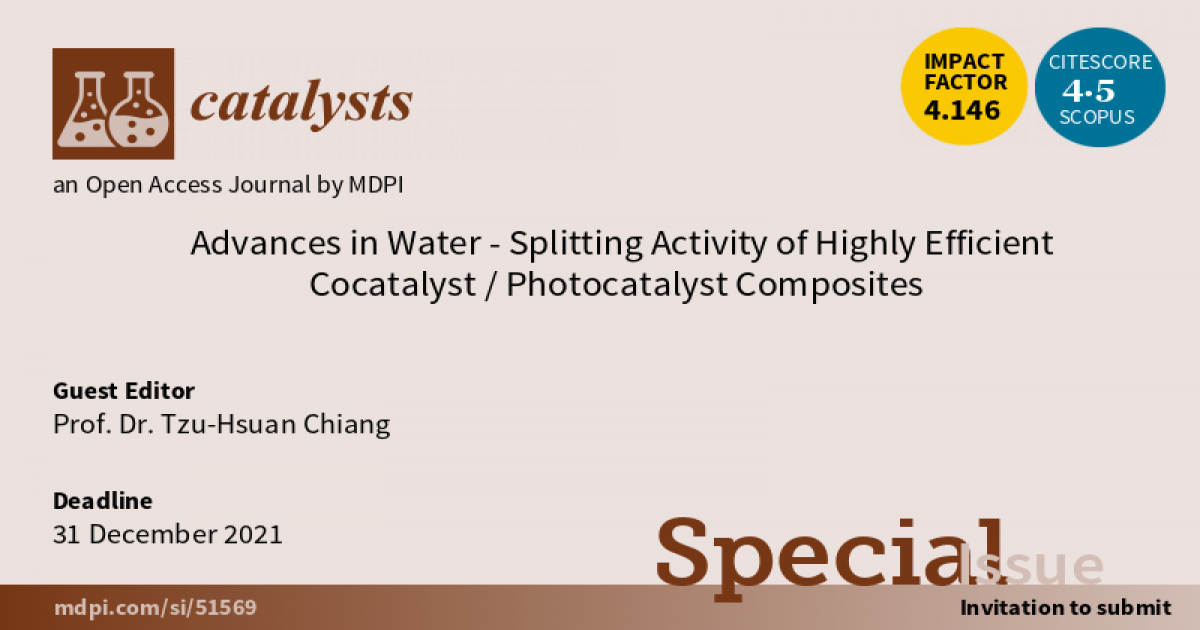Advances in Water-Splitting Activity of Highly Efficient Cocatalyst/Photocatalyst Composites
A special issue of Catalysts (ISSN 2073-4344). This special issue belongs to the section "Photocatalysis".
Deadline for manuscript submissions: closed (31 December 2021) | Viewed by 30382

Special Issue Editor
Interests: electrocatalysts and photocatalysts for overall water splitting and CO2 reduction; electrocatalysts for Zn–air batteries; photocatalysts for dye degradation
Special Issue Information
Dear Colleagues,
The development of highly efficient photocatalytic water splitting through an advanced cocatalyst and photocatalyst system has attracted considerable interest. The construction of an efficient cocatalyst and photocatalyst system is essential for promoting surface catalytic reactions. First, the photocatalysts should possess a band gap to match not only an efficient light absorption wavelength but also suitable conduction band and valence band levels for water-splitting redox reactions. Then, loading cocatalysts on to the surface of a photocatalyst to provide active sites accelerates the photocatalytic reaction and consequently improves the efficiency of overall water splitting. It should be emphasized that the processes of charge separation and surface catalytic reactions are synergistically correlated. In addition, the heterostructures, nanostructures, and nanosheets of photocatalysts can improve light absorption characteristics and shorten electron and hole migration paths to the surface of photocatalysts. The design of cocatalysts and photocatalysts structures is important for charge separation and surface catalytic reactions and should be discussed for the construction of highly efficient photocatalyst systems.
This Special Issue aims to cover the most recent progress and the advances in the field of cocatalyst and photocatalyst composites. This includes, but is not limited to, cocatalysts (e.g., noble, non-noble metal, and metal oxide cocatalysts), photocatalysts (e.g., nanostructures, 2D and 3D structures, and nanosheets), and photocatalyst composites (e.g., Z-scheme, graphene based, heterostructures, and heterojunction).
Prof. Dr. Tzu-Hsuan ChiangGuest Editor
Manuscript Submission Information
Manuscripts should be submitted online at www.mdpi.com by registering and logging in to this website. Once you are registered, click here to go to the submission form. Manuscripts can be submitted until the deadline. All submissions that pass pre-check are peer-reviewed. Accepted papers will be published continuously in the journal (as soon as accepted) and will be listed together on the special issue website. Research articles, review articles as well as short communications are invited. For planned papers, a title and short abstract (about 100 words) can be sent to the Editorial Office for announcement on this website.
Submitted manuscripts should not have been published previously, nor be under consideration for publication elsewhere (except conference proceedings papers). All manuscripts are thoroughly refereed through a single-blind peer-review process. A guide for authors and other relevant information for submission of manuscripts is available on the Instructions for Authors page. Catalysts is an international peer-reviewed open access monthly journal published by MDPI.
Please visit the Instructions for Authors page before submitting a manuscript. The Article Processing Charge (APC) for publication in this open access journal is 2200 CHF (Swiss Francs). Submitted papers should be well formatted and use good English. Authors may use MDPI's English editing service prior to publication or during author revisions.
Keywords
- cocatalysts
- photocatalytic water splitting
- heterostructures
- Z-scheme
- photocatalyst composites
Benefits of Publishing in a Special Issue
- Ease of navigation: Grouping papers by topic helps scholars navigate broad scope journals more efficiently.
- Greater discoverability: Special Issues support the reach and impact of scientific research. Articles in Special Issues are more discoverable and cited more frequently.
- Expansion of research network: Special Issues facilitate connections among authors, fostering scientific collaborations.
- External promotion: Articles in Special Issues are often promoted through the journal's social media, increasing their visibility.
- e-Book format: Special Issues with more than 10 articles can be published as dedicated e-books, ensuring wide and rapid dissemination.
Further information on MDPI's Special Issue polices can be found here.





